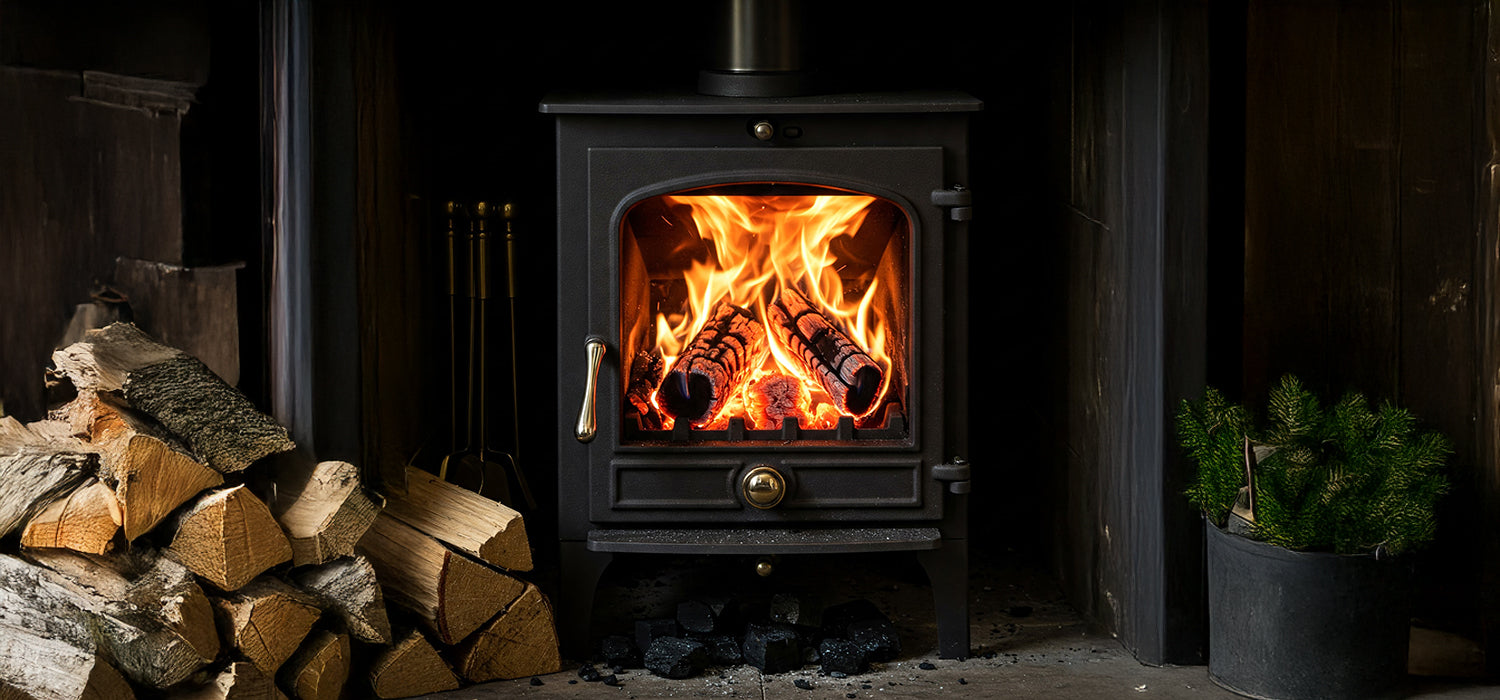
Can You Safely Install a Log Burner Near Glass?
Thinking of putting a log burner near glass? Short answer: Yes, but with care! Heat-loving log burners can make your windows sweat, warp, or even crack if you’re not careful. Understanding safe distances, protective materials, and expert guidance keeps your home cosy without turning your glass into a fire hazard.
Installing a Log Burner Near Glass: What You Need to Know
Placing a log burner near a window or glass wall isn’t as simple as it seems. Many homeowners imagine a roaring fire framed by sparkling glass, but the reality is more nuanced. Too much heat in the wrong spot can stress your windows, leaving tiny cracks or even shattered panes.
Different types of glass handle heat differently. Standard window glass is the most vulnerable, while toughened or ceramic glass can cope with closer proximity. Knowing these differences helps you plan your stove layout safely.
Your log burner’s heat output, the room’s ventilation, and surrounding materials all play a role. Even a small miscalculation can lead to costly damage—or worse, a safety hazard. That’s why careful planning is key.
The Rules of Proximity: Why Clearance is Crucial
Think of a log burner as a mini sun in your living room. The closer you put glass to it, the hotter it gets, and the higher the risk of thermal stress. Glass expands and contracts with heat, and if it does so unevenly, fine cracks appear.
A good rule of thumb is: the more ordinary your glass, the more distance it needs. Standard windows should usually sit at least 300–500mm from a stove, while specialist heat-resistant glass can safely go a little closer.
Proper clearance doesn’t just prevent damage—it protects everyone in the room. After all, no one wants a cracked window ruining a cosy evening by the fire.
Specifics for Conservatory and Glass-Walled Rooms
Conservatories and glass-walled spaces are a different ball game. Large panes of glass and lighter framing can amplify heat stress.
Imagine a chilly autumn evening: you light your log burner for the first time, and soon notice the glass behind it fogging up or feeling warm to the touch. That’s your first warning that extra precautions are needed.
In these rooms, you may need specialist heat-resistant glass or larger clearances. Heat shields or barriers are also highly recommended to prevent warping and thermal shock. A small investment in protection goes a long way to keeping your beautiful glass intact.
How to Safely Install a Log Burner Near Glass
Installing a log burner safely is about more than just placement. It’s about understanding how heat moves, how materials react, and how to use protective measures effectively.
Even experienced homeowners can underestimate the effect of radiant heat. A professional approach ensures your log burner warms the room, not damages your windows.
Understanding the Heat Zones
Every log burner has three heat zones: the immediate area around the stove, a mid-range warmth, and the far-reaching ambient heat. Glass nearest the stove absorbs the most energy, making it more vulnerable to thermal stress.
You can test heat zones using a stove thermometer or, for a more thorough approach, thermal imaging. Spotting hotspots early helps you adjust distances and add protection before any damage occurs.
Understanding these zones also helps with fuel choices. Hardwoods like oak and beech burn steadily, giving off predictable heat, while wet or soft wood can spike temperatures dangerously.
Using Heat Shields and Protective Materials
Heat shields are an essential part of protecting glass near log burners. They act as a barrier, reflecting or absorbing heat before it reaches delicate surfaces.
Options include:
-
Ceramic panels: Reflect and diffuse heat, reducing stress on the glass.
-
Reflective metal barriers: Direct heat away from sensitive areas.
-
Insulated air gaps: Add a buffer to cut down thermal impact.
Correct installation is key. Even the best materials won’t work if positioned incorrectly. A certified installer can advise on distances, ventilation, and aesthetics so your shield protects without looking out of place.
Key Regulations and Building Control Guidance
In the UK, regulations aren’t optional—they’re there for a reason. Document J of the building regulations sets out minimum distances and ventilation requirements for log burners.
Local authorities may have additional rules, and HETAS offers detailed guidance on safe installation near glass. Following these rules ensures your stove is legally compliant and safe.
Using certified professionals is strongly recommended. HETAS-registered installers bring experience, insurance, and up-to-date knowledge of building regulations. They can check structural compatibility, measure safe clearances, and carry out safety testing, giving you peace of mind alongside your cosy flames.
Maintaining Safe Temperatures and Best Practices
Once your log burner is installed, keeping temperatures in check is crucial. Use a heat-resistant thermometer to monitor stove surface temperatures and avoid overheating.
Regularly inspect glass for stress signs such as tiny cracks, discolouration, or warping. Clean glass surfaces help you spot problems early before they worsen.
Choosing the right fuel is another simple way to control heat. Dry, seasoned hardwoods burn efficiently and safely, while wet or green wood produces unpredictable heat and smoke. Good airflow and ventilation also spread warmth evenly, reducing stress on glass surfaces.
When to Call in the Experts
Some signs of heat damage require professional attention. Deep cracks, significant warping, or unusual glass flexibility should be assessed by a qualified installer.
Experts can advise on repairs, replacements, or additional protection. They also provide guidance on your log burner’s ongoing use, ensuring both comfort and safety.
Conclusion
Putting a log burner near glass can be done safely with planning, the right materials, and expert guidance. Understanding heat zones, maintaining clearances, and installing heat shields all help protect your windows.
Follow UK regulations, use certified installers, and inspect your setup regularly. With care and attention, your log burners can bring warmth, charm, and safety to your home—even in rooms full of glass.
Other content we think you'll love
- What Are the New Log Burner Rules in the UK?
- Why Your Log Burner is Smoking: Causes, Fixes, and Safety Tips
- Why Does My Log Burner Smell?
- Why Your Log Burner Is Burning Too Fast (And How to Fix It)
- Why Does My Log Burner Keep Smoking? Common Causes & Fixes
- Why Your Log Burner Won’t Stay Lit (and How to Fix It)
- Why Is My Log Burner Smoking? Causes, Fixes & Prevention
- Can You Safely Put a TV Above a Log Burner?
- Keeping Your Baby Safe Around Log Burners
- Why Your Fireplace Smells Like Burning Plastic (and What to Do About It)
- Log Burner Carbon Monoxide: Stay Safe from the Silent Killer
- Log Burner Law UK: The Complete Guide for Homeowners

